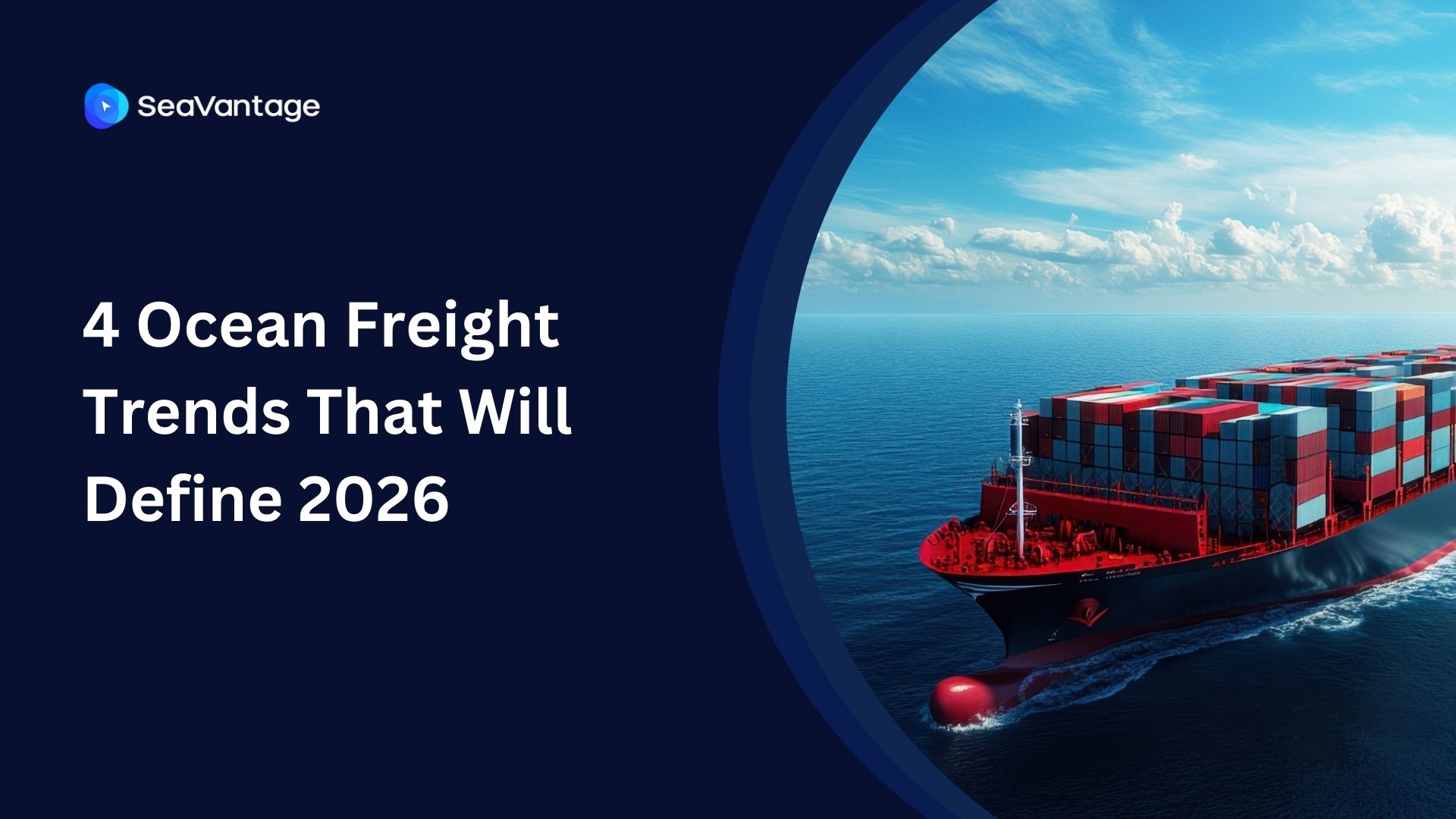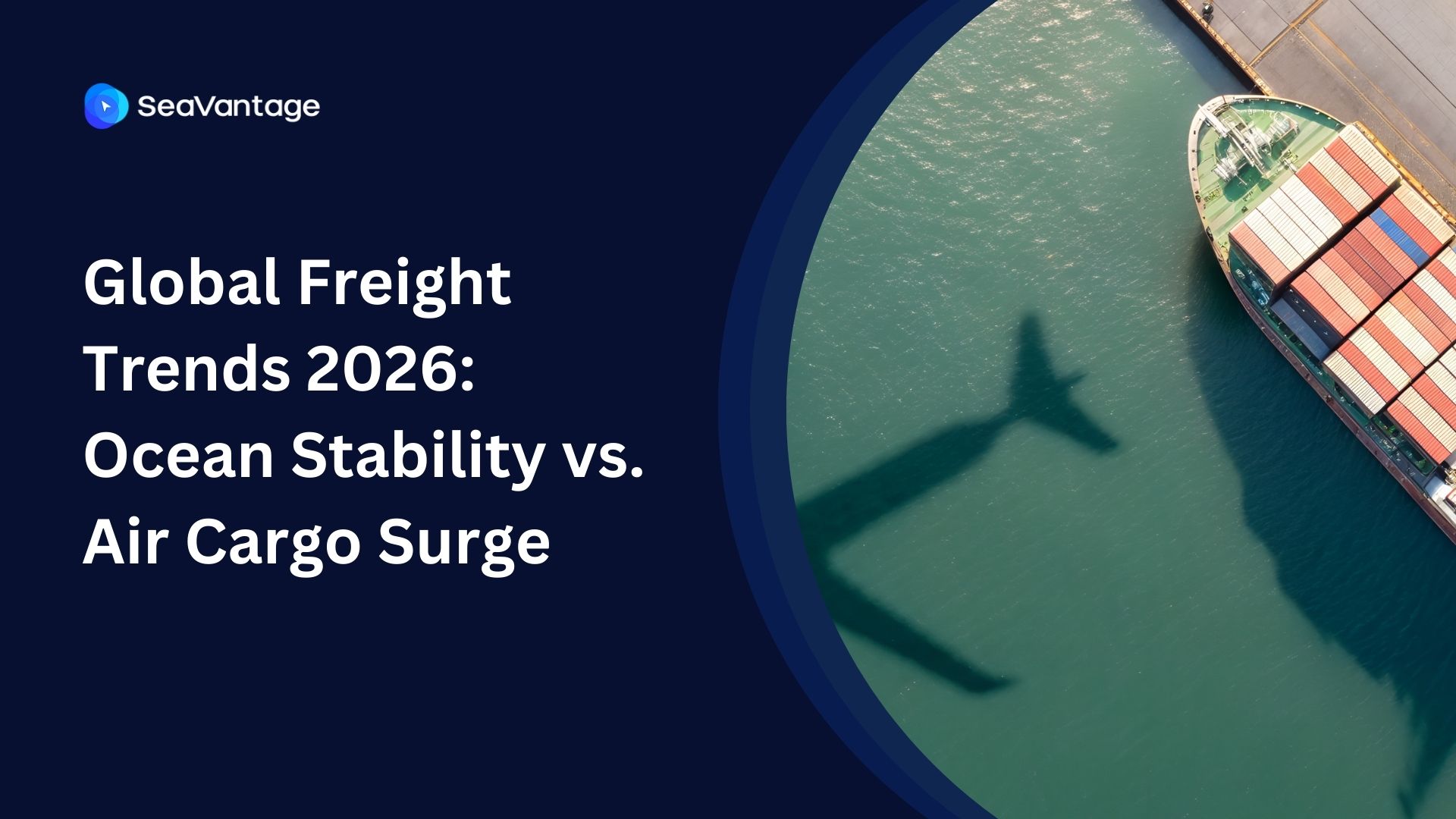How Chinese Vessel Policies and Tariffs Are Impacting Volumes at U.S. Ports
Summary
Recent U.S. policies, including steep tariffs on Chinese imports and proposed fees for Chinese-built vessels, are significantly disrupting global ocean freight and forcing recalibrated trade strategies due to concerns over China's shipbuilding dominance. SeaVantage data (Jan-May 2025) reveals a dramatic decline in China-built container ship calls to U.S. West Coast ports—with decreases of up to 83% in Oakland, 71% in Los Angeles, and 50% in Long Beach between April and May.
Conversely, East Coast ports like New York have shown stability, indicating an eastward cargo shift. This policy-driven volatility is upending traditional shipping patterns, leading to potential congestion in newly favored ports, increased carrier costs, and a push for sourcing diversification beyond China. Stakeholders now require enhanced agility and real-time data, like that from SeaVantage, to navigate sustained market uncertainty and strategically reassess supply chains.
Download the Report
Introduction
The maritime landscape surrounding U.S. ports is shifting at a rapid pace. Tensions in U.S.–China trade relations, combined with newly imposed vessel fees and persistent tariffs, are redrawing the flow of cargo, altering operating costs, and reshaping long-term logistics strategies. These developments aren't just abstract policy shifts—they're impacting daily port operations, influencing shipping behaviors, and affecting businesses across the entire supply chain.
This article unpacks the latest changes and implications, guided by recent government measures, insights from key industry voices, including Gene Seroka, Executive Director of the Port of Los Angeles, and an analysis of recent port call data for China-built container ships from SeaVantage.
New U.S. Measures: A Direct Hit on Chinese Maritime Operations
In a bid to reduce Chinese influence over global shipping routes, the United States has implemented a series of focused regulatory actions. These policies are already reverberating through port operations nationwide.
Key Policy Measures
Fees on Chinese-Owned or Operated Vessels
Vessels owned or operated by Chinese entities now face a fee of $50 per net ton per voyage. This fee is set to increase annually by $30, reaching $140 per net ton by 2028. To prevent excessive charges, a maximum of five assessments per vessel per year will be applied.
Charges on China-Built Vessels
Ships constructed in China—regardless of operator nationality—are charged $18 per net ton or $120 per container, with both rates scheduled to increase annually. By 2028, the container-based fee will reach $250. These charges are also capped at five voyages per vessel annually.
Importantly, these charges apply per voyage, rather than per port call, a key distinction that could have broader consequences for carriers with multi-stop itineraries.
Exemptions and Incentives
Exemptions apply to vessels servicing domestic U.S. routes, Caribbean ports, U.S. territories, and the Great Lakes. Additionally, foreign vessels calling at U.S. ports solely to pick up export cargo may be exempt. Operators who commit to purchasing U.S.-built vessels may be eligible for temporary fee waivers or tax suspensions of up to three years.
Implementation Timeline
These measures will take effect on October 14, 2025, with a 180-day grace period to allow the industry time to adjust.
Equipment Tariffs Add to the Financial Strain
The pressure extends beyond vessels alone. Tariffs of up to 100% have been levied on Chinese-manufactured port equipment, including ship-to-shore cranes. Additional duties now also affect containers and chassis.
These combined measures are driving up the operational costs for shipping lines. Many are evaluating whether to reroute or reduce port calls to mitigate expenses. The effects are not isolated—inland logistics and warehouse operations are already feeling the ripple effect.
Then came another blow.
On April 2, 2025, the U.S. imposed a sweeping 145% tariff on select Chinese goods. The targeted categories were deemed strategically sensitive, sparking widespread concern across the logistics and import communities.
Following international backlash and intense negotiations, the tariff was lowered to 30% just weeks later, with a 90-day reprieve. While this adjustment provided some relief, uncertainty remains. The new baseline rate—still significantly higher than before—continues to impact market confidence and planning cycles.
The 30% Tariff Tightrope: A Heavy Load for U.S. Ports
Though scaled back from the extreme 145%, the 30% tariff is far from benign.
Gene Seroka, speaking to The Wall Street Journal and later cited by WorldCargo News, addressed the lingering challenges:
"Even at a 30% tariff with a 90-day reprieve, it's not going to dramatically change what we're seeing right now."
His outlook is sobering. The Port of Los Angeles is bracing for a 25% year-over-year decline in imports for May—a powerful indicator of how fragile current trade flows have become.
And it’s not an isolated case. Across major U.S. gateways, ports that saw record-setting volumes in April are now facing sharp reversals. Long Beach, Savannah, and Oakland each tell a version of the same story: a brief surge, followed by an abrupt slowdown tied directly to tariff policy. The whiplash effect of these trade measures underscores just how sensitive the system has become
Why the 30% Tariff Still Matters
Demand Suppression and Margin Pressure For many goods with thin profit margins, a 30% tariff is enough to erase competitiveness. As prices rise, demand drops—leading to fewer shipments arriving from China.
Sourcing Diversification Accelerates Companies are responding quickly. Southeast Asia, Mexico, and other regions are becoming more attractive for sourcing. These shifts are already altering global trade routes, with direct implications for U.S. port volumes.
Beating the Clock: Importers Front-Load Goods Amid Tariff Uncertainty
To stay ahead of potential tariff hikes or the expiration of relief measures—rumored to end by August—U.S. importers are rushing to front-load their shipments. The goal: clear customs before costs spike again.
Implications of Front-Loading
Compressed Peak Seasons Instead of gradual, planned deliveries, goods are arriving in rapid succession—creating short-term cargo surges.
Short-Term Rate Pressure Peter Sand, Chief Analyst at Xeneta, notes that these demand spikes are placing upward pressure on freight rates, especially along Asia–U.S. lanes.
A Temporary Surge Meets Persistent Volatility
While front-loading may help avoid cost increases in the near term, it creates instability across the logistics chain.
Key Impacts:
Capacity Constraints The sudden influx of cargo strains vessel availability, container supply, and terminal infrastructure.
Freight Rate Escalation Limited capacity, combined with increased demand, drives rates higher. In some cases, carriers introduce premium surcharges as shippers rush to meet policy deadlines.
Market Whiplash Once the surge subsides, demand often falls off quickly—prompting sharp rate corrections. This "boom and bust" cycle complicates planning for shippers, carriers, and port authorities alike.
Gene Seroka welcomed the 90-day pause but emphasized the need for more durable solutions:
"Both sides should work together swiftly toward a long-term agreement."
Still, the current 30% tariff and a clear pivot away from Chinese sourcing signal that today's disruptions may well become tomorrow's standard.
SeaVantage Data-Driven Analysis: China-Built Vessel Activity Confirm Market Predictions
Recent vessel tracking data from SeaVantage provides compelling empirical evidence supporting the industry concerns outlined above. Analysis of China-built container ship callings across major U.S. ports from January through May 2025 reveals stark patterns that align precisely with executive forecasts and market intelligence.
Container Ship Callings by Port (Built in China)
The chart below shows the number of container ship callings at selected U.S. ports, specifically for ships that were built in China. This dataset only includes vessels for which the country of construction has been confirmed.
Total Callings (ship_count): This is the total number of times container ships (built in China) called at a given port in a specific month.
Distinct Ships (unique_ship_count): This counts how many unique vessels (not repeated) made those calls during the month.
Data coverage: January through May 2025 (up to and including May 25th, UTC)
West Coast Ports: Sharp Decline Validates Executive Warnings
The data confirms Gene Seroka's dire predictions for May. At the Port of Los Angeles, China-built vessel callings plummeted from 17 total calls in April to just 5 in May—a 71% monthly decline. This dramatic reduction validates the reported drop in TEU arrivals from 120,608 TEUs in late April to 62,568 TEUs in early May.
Long Beach experienced an equally severe contraction, with China-built vessel calls falling 50% from 30 in April to 15 in May. This pattern supports Long Beach's exposure to Chinese trade flows, where 63% of cargo originates from China—making the port particularly vulnerable to policy-induced trade disruptions.
Oakland showed the most extreme proportional decline, dropping from 18 callings in April to merely 3 in May—an 83% reduction that underscores the port's acute sensitivity to China trade volatility.
East Coast Resilience: New York Maintains Stability
In stark contrast to West Coast volatility, the Port of New York maintained remarkably consistent China-built vessel activity throughout the period, ranging between 28-32 callings per month with no discernible May decline. This stability suggests that East Coast ports may be benefiting from diversified trade relationships or alternative routing strategies that provide insulation from direct China-focused policy impacts.
Savannah: Moderate Impact Indicates Regional Diversification
The Port of Savannah experienced a modest decline from 22 callings in April to 14 in May—a 36% reduction that, while significant, demonstrates greater resilience than West Coast counterparts. This pattern suggests that Southeast ports may be positioned to capture some of the trade flows diverted from traditional West Coast gateways.
Implications for Strategic Planning
The vessel calling data reveals three critical strategic insights:
Geographic Trade Route Rebalancing: The dramatic West Coast decline coupled with East Coast stability indicates a fundamental shift in trans-Pacific trade routing. Logistics professionals should anticipate continued eastward cargo migration and plan capacity accordingly.
Seasonality Disruption: Traditional peak season patterns are being overridden by policy-driven volatility. The May collapse follows April's record-breaking volumes, creating unprecedented demand variability that challenges conventional forecasting models.
Infrastructure Utilization Efficiency: Ports maintaining stable calling patterns (New York) are likely operating at higher capacity utilization rates, while volatile ports face underutilized assets during downturn periods.
Navigating the Shifts with SeaVantage
In such an unpredictable environment, real-time visibility becomes not just beneficial—but essential.
SeaVantage provides comprehensive container data to help logistics teams plan and adapt effectively. Whether it’s shifting carrier behavior, or change in congestion at key terminals, staying informed allows businesses to respond, not react.
SeaVantage Capabilities at a Glance
1. Monitor the number of Chinese vessels arriving at U.S. ports
2. Identify high-volume Chinese vessel ports at a glance
3. Use Ship Insight to track individual vessels and analyze port trends
4. Access port congestion data for delay insights by terminal
5. Leverage container tracking for real-time visibility during disruptions
These tools help teams anticipate changes, reroute intelligently, and stay agile—regardless of the policy environment.
Final Thoughts: Preparing for Ongoing Uncertainty
For businesses operating within global trade networks, flexibility and timely information are more valuable than ever. The vessel calling data analysis demonstrates that policy impacts materialize rapidly and with significant magnitude—making reactive strategies insufficient for maintaining competitive advantage.
With tariffs in flux, sourcing strategies evolving, and policy risks on the rise, organizations must build resilience into every layer of their operations. The empirical evidence from China-built vessel movements provides a clear roadmap: West Coast ports face continued volatility, East Coast gateways offer stability advantages, and Southeast ports present emerging opportunities for trade flow capture.
The U.S. port system—and the businesses that depend on it—are learning to navigate not only ocean currents but also the shifting tides of global politics. Organizations that invest in advanced maritime intelligence, predictive analytics, and dynamic routing capabilities will emerge stronger from this period of unprecedented trade volatility.
Success in this environment requires moving beyond traditional reactive approaches toward proactive, data-driven supply chain management. The vessel calling patterns observed across U.S. ports provide both warning and opportunity—for those equipped to interpret and act upon the signals embedded within maritime trade flows.
2025년 9월, 주요 글로벌 항만에서 어떤 운송사가 가장 긴 선박 체류 시간을 기록했는지 확인해보세요. 트렌드를 비교하고, 지연을 파악하며, 전체 항만 데이터를 통해 운송 전략을 최적화할 수 있습니다.
2025년 8월, 주요 글로벌 항만에서 어떤 운송사가 가장 긴 선박 체류 시간을 기록했는지 확인해보세요. 트렌드를 비교하고, 지연을 파악하며, 전체 항만 데이터를 통해 운송 전략을 최적화할 수 있습니다.
2025년 7월, 주요 글로벌 항만에서 어떤 운송사가 가장 긴 선박 체류 시간을 기록했는지 확인해보세요. 트렌드를 비교하고, 지연을 파악하며, 전체 항만 데이터를 통해 운송 전략을 최적화할 수 있습니다.
iscover the 4 critical ocean freight trends for 2026, from the Red Sea reopening and fleet overcapacity to shifting global trade maps. Prepare your supply chain now.
Discover key 2026 freight market trends: Port of Houston expansion, air cargo "super peak," and ocean freight stability. Plan your supply chain with SeaVantage.
Explore November 2025 global port dwell time data. See which ports and carriers led in efficiency across Antwerp, Busan, Long Beach, Rotterdam, and Singapore.



.svg)





.jpg)

.png)